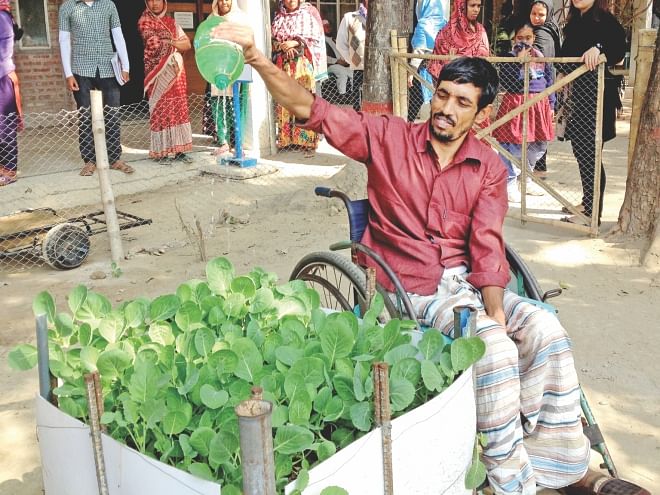Occupational therapy at CRP cures disabled farmers
Occupational therapy at CRP cures disabled farmers

I present to you a unique paradise of love, called the Centre for the Rehabilitation of the Paralysed, or CRP in short. Most of the people in our country are farmers who regularly face different occupational hazards. Many of them suffer injuries and ultimately some of them become physically disabled. These people have access to CRP's occupational therapies, which are curing them fast.
A foreign lady planted a seed of love in Bangladesh 45 years ago. Today we feel so proud to say that she is ours. She is Valerie A. Taylor, a legendary physiotherapist. In 1969, she came to the then East Pakistan from Kent, England, as a volunteer of VSO (Voluntary Service Overseas), an international development charity, when she was only 25 years old. She was repatriated from Bangladesh during the liberation war, however returned during September, 1971 in the middle of heavy war across Bangladesh. She persevered with her skills to give service to wounded freedom fighters. She wanted to set off a physiotherapy institution in Bangladesh, for the first time in the country. The dream finally came true in 1979. CRP is situated in Savar, at the outskirt of Dhaka on 10 acres of land. Here, on more than 150 beds, physically disabled people are being healed. You can literally see them coming back to life. Starting its humanitarian voyage in 1979, CRP now has nine centres where 780 dedicated souls work relentlessly to give service to at least 50,000 patients every year.
I entered one of the prime spots at CRP, which, I think should be named 'Ananda Kanan' (Garden of Bliss). Physically disabled people regain their strength from soil, crops, fruits, flora and nature itself from this very garden. Here, they are strengthened to become self confident, through very innovative occupational therapy. When they'll go back, they'll start a new life in nature, with farming activities. I saw a group of 20 patients, people who have suffered different accidents- some fell from tree, or an auto-rickshaw. But most of these people were involved with agricultural activity. These people will go back to their home after long term treatment. They'll start working on what they used to - farming. Swapan, who comes from Comilla, fell from a tree and became disabled. His dreams lost route. But they are coming back now through rehabilitation.
“What happened to you?”
“I fell from a tree and my spine was severely injured.”
“Do you believe that you can work like before when you go back?”
“Definitely. I feel joyous when I am involved with agricultural activity with the modified tools. It gives me immense hope.”
There is a raised bed section in the plot. To cut the cost, they're using bamboos here. I could see how easily patients can work on the bed, sitting on a wheelchair. I saw a patient was busy with tomatoes that he grew himself with the cooperation from CRP occupational therapists. Tasin, a child full of dreams is from Chourhash, Kushtia.
“I can't straighten my fingers. With good care in CRP, now I can walk on support with the help of my therapist. The muscle power of my fingers is very poor, that's why I can't straighten them. As I do different agricultural activities, my level of activity in my finders is gradually increasing.”
Another patient was really happy as he can now work the way used to do in the past.
“Even as a patient I can work like a farmer. It's certainly a great feeling.”
There are many volunteers from home and abroad who joined CRP to serve the cause of humanity. Their philosophy has changed entirely.
Fatema Tuz Zohora, Occupational Therapist at CRP believes that there is nothing called disability. “If we can raise the bed and modify the tools, the patient can also work like a regular farmer. I don't see any difference” , says Fatema.
I saw a special kind of a spade and the patients are using it easily. It's quite long and very light. It's made so simply that they can easily do the spade work, sitting on the wheelchair. When the patients are ready to go home, they're brought to a special place for two weeks before they depart. The place gives them the image of a rural house, their past. This is a two-week adaptation dwelling where I saw vegetables, pigeons and homestead gardening.
Finally it was time to meet the ever-smiling Valerie A. Taylor, the lover of life and the human spirit.
“What's your observation on Bangladeshi people?”
“Bangladeshi people are like my family members. The hospitality in this country is remarkable.”
“Why didn't you go back to England?”
“The people, their spirit, the way they teach us to survive, it's really wonderful. Once I stepped on this soil, I felt that I am home.”
“I can see how much people love you here.”
“It's an honour to be with them. I am sure these occupational therapies would give them a new life to breath when they leave CRP. They just need a bit of support from their families.”
Each of the lives of these people is engraved in one unique philosophy: “There is nothing alternative to love,” and the patients here do not see CRP with their eyes, but do so with their hearts and minds.
Shykh Seraj is an Agriculture Development and Media Activist. He is an Ashoka Fellow and an FAO A.H. Boerma Awardee. At Channel i, he is Director and Head of News. He is also Director, Planner and Presenter of the popular Agro-Documentary “Hridoye Mati O Manush”.